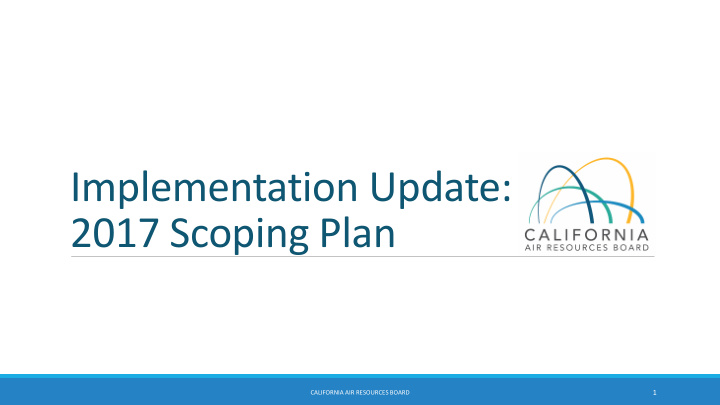



Implementation Update: 2017 Scoping Plan 1 CALIFORNIA AIR RESOURCES BOARD
California GHG Emissions Reduction Targets Source: CARB, 2017 2 CALIFORNIA AIR RESOURCES BOARD
Climate Policy in a Changing Environment CARB must be flexible and adapt its programs to ever changing factors Latest scientific findings Health, air quality, climate, etc. Increasing impacts of climate change Latest technological developments Economic conditions Smooth transitioning to a sustainable future while balancing affordability and jobs for all Californians today Economic stimulus can support sustainable future 3 CALIFORNIA AIR RESOURCES BOARD
2017 Scoping Plan Portfolio ** **In 2018, SB 100 increased the Renewables Portfolio Standard to 60% by 2030 4 CALIFORNIA AIR RESOURCES BOARD
Scoping Plan: Implementation is Critical To achieve the GHG targets and air quality co-benefits, we must invest the resources and remain committed to ensuring the Scoping Plan policies are successfully implemented 2019 Highlights 100% compliance in the Cap & Trade and the Low Carbon Fuel Standard (LCFS) programs LCFS incentivized displacement of over 2.5 billion gallons of petroleum fuel Estimated Reductions >450 tons Diesel PM, >600 tons NOx Large investor-owned utilities are over-complying with the Renewables Portfolio Standard Over 100 dairy biogas capture projects funded by CDFA through CA Climate Investments California Climate Investments to support Low Carbon Transportation Programs 5 CALIFORNIA AIR RESOURCES BOARD
Lessons Learned Thoughtfully designed programs have pushed clean technology and fuels Exportable programs are necessary to address global emissions Revenues from carbon pricing continue to be important for addressing environmental justice and equity concerns Retirement and public funds (i.e. economic recovery and stimulus packages) need to be leveraged to support a sustainable future Reductions in fossil transportation fuels and VMT remain a challenge. Current situation may provide data on how to implement existing programs 6 CALIFORNIA AIR RESOURCES BOARD
Protecting our Future 7 CALIFORNIA AIR RESOURCES BOARD
Mid-Century Carbon Neutrality (CO2e) Step 1: Strive for Step 2: Maximize zero emissions Sequestration from all sources Carbon capture and sequestration Fossil Energy Sources Direct air capture Industrial Processes = Sinks Natural and working Natural and working lands lands 8 CALIFORNIA AIR RESOURCES BOARD
Charting the Path to Carbon Neutrality CALIFORNIA AIR RESOURCES BOARD 9
Ongoing Multi-Agency Efforts CARB interagency collaborations AB 74 - Transportation Carbon Neutrality Studies will evaluate how to reduce demand for fossil fuels in the sector and how to manage the subsequent decline for supply SB 100 - Zero Carbon Electricity Retail Sales by 2045 SB 1440 – Consideration of annual biomethane procurement targets for each gas corporation Continued efforts to reduce emissions from Natural and Working Lands 10 CALIFORNIA AIR RESOURCES BOARD
Focus on Transportation Sector: Critical New Paradigm Necessary Aggressive strategies needed to meet health-based air quality standards, SB 32 GHG requirements, and carbon neutrality in 2045 By 2045: Goal is zero-emission transportation sector through transformative action ZEVs, coupled with Sustainable infrastructure that communities that increases climate improve travel choices resiliency and reduce VMT 11 CALIFORNIA AIR RESOURCES BOARD
Options for Sequestration (sinks) to Complement Mitigation Natural and working lands Emit greenhouse gases, must be managed to emit less and store more carbon over time Carbon capture and sequestration (CCS) Capture and store carbon from large emitters (cement, refineries) Direct air capture Capture and store carbon from the atmosphere 12 CALIFORNIA AIR RESOURCES BOARD
Focus on Natural and Working Lands Reaching carbon neutrality will require reduced emissions and increased sequestration on California lands A few key policy questions moving forward: What existing mechanisms can be expanded to increase the pace and scale of climate actions on our natural and working lands? What new mechanisms can be employed to increase these actions? What are the key interactions between sectors that should assessed with relation to natural and working lands? 13 CALIFORNIA AIR RESOURCES BOARD
Key Considerations Strive for zero emissions from every sector (transportation, industry) Technologically feasible, cost-effective, minimal impacts to households and jobs What can maximize air-quality benefits for most vulnerable communities Reduce and replace fossil fuels Potential limits to electrification, best use of RNG and renewable hydrogen Maximum potential for sequestration in natural and working lands Lessons learned from current public health and economic situation to inform strategies and implementation of emissions reductions efforts As part of economic recovery efforts, supporting investments and economic stimulus packages critical for a sustainable future and not back to status quo 14 CALIFORNIA AIR RESOURCES BOARD
Next Steps Through 2020, continue public process on carbon neutrality Report to Board in late 2020 with key carbon neutrality findings Initiate Scoping Plan development process in Q1 2021 Convene the Environmental Justice Advisory Committee Through 2021, periodic updates to Board on Scoping Plan development progress 2022, workshops and release draft and final 2022 Scoping Plan Updates 15 CALIFORNIA AIR RESOURCES BOARD
THANK YOU 16
Recommend
More recommend